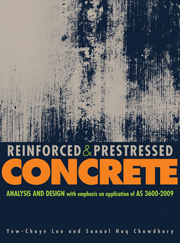Book contents
- Frontmatter
- Contents
- Preface
- Acknowledgements
- Notation
- Acknowledgements for tables and diagrams
- Acronyms and abbreviations
- Part I Reinforced concrete
- Part II Prestressed concrete
- Appendix A Elastic neutral axis
- Appendix B Critical shear perimeter
- Appendix C Development of an integrated package for design of reinforced concrete flat plates on personal computer
- Appendix D Strut-and-tie modelling of concrete structures
- Appendix E Australian Standard precast prestressed concrete bridge girder sections
- References
- Index
Appendix C - Development of an integrated package for design of reinforced concrete flat plates on personal computer
- Frontmatter
- Contents
- Preface
- Acknowledgements
- Notation
- Acknowledgements for tables and diagrams
- Acronyms and abbreviations
- Part I Reinforced concrete
- Part II Prestressed concrete
- Appendix A Elastic neutral axis
- Appendix B Critical shear perimeter
- Appendix C Development of an integrated package for design of reinforced concrete flat plates on personal computer
- Appendix D Strut-and-tie modelling of concrete structures
- Appendix E Australian Standard precast prestressed concrete bridge girder sections
- References
- Index
Summary
Summary
Details of UNIDES-FP, a reinforced concrete flat plate design package for personal computers are discussed. Based on the “idealized frame” approach and the relevant clauses recommended in the Australian Concrete Structure Code AS 3600-1988, the package is developed as a tool for the practising engineer and architect alike whose skills and experience are incorporated interactively in the design process.
Analyses of all the code specified loading conditions are carried out using an integrated plane frame program. For slab punching shear check, the effects of capital/drop panel and shear head may be included; torsion strips and spandrel beams are designed as desired. Deflections are checked for each slab. In the design of the braced and unbraced columns, biaxial bending effects can be considered. All design results are in tabulated form ready for drafting.
Introduction
As a result of the exponential spreading of the use of personal computers, there has been a considerable amount of research effort spent worldwide in developing structural engineering software. Large finite element analysis systems are now available on the most basic IBM PC. In comparison, the development work on personal-computer based structural design software is negligible.
As academic exercises, several microcomputer-based integrated design packages have been developed under the author's supervision, for reinforced concrete [1] and steel structures [2, 3]. However, no attempt was made to refine such systems to render them useful for practising engineers.
- Type
- Chapter
- Information
- Reinforced and Prestressed ConcreteAnalysis and Design with Emphasis on Application of AS3600-2009, pp. 391 - 397Publisher: Cambridge University PressPrint publication year: 2010



